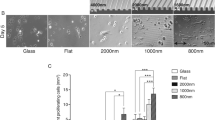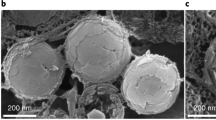Abstract
Insect eyes have an anti-reflective coating, owing to nanostructures on the corneal surface creating a gradient of refractive index between that of air and that of the lens material1,2. These nanocoatings have also been shown to provide anti-adhesive functionality3. The morphology of corneal nanocoatings are very diverse in arthropods, with nipple-like structures that can be organized into arrays or fused into ridge-like structures4. This diversity can be attributed to a reaction–diffusion mechanism4 and patterning principles developed by Alan Turing5, which have applications in numerous biological settings6. The nanocoatings on insect corneas are one example of such Turing patterns, and the first known example of nanoscale Turing patterns4. Here we demonstrate a clear link between the morphology and function of the nanocoatings on Drosophila corneas. We find that nanocoatings that consist of individual protrusions have better anti-reflective properties, whereas partially merged structures have better anti-adhesion properties. We use biochemical analysis and genetic modification techniques to reverse engineer the protein Retinin and corneal waxes as the building blocks of the nanostructures. In the context of Turing patterns, these building blocks fulfil the roles of activator and inhibitor, respectively. We then establish low-cost production of Retinin, and mix this synthetic protein with waxes to forward engineer various artificial nanocoatings with insect-like morphology and anti-adhesive or anti-reflective function. Our combined reverse- and forward-engineering approach thus provides a way to economically produce functional nanostructured coatings from biodegradable materials.
This is a preview of subscription content, access via your institution
Access options
Access Nature and 54 other Nature Portfolio journals
Get Nature+, our best-value online-access subscription
$29.99 / 30 days
cancel any time
Subscribe to this journal
Receive 51 print issues and online access
$199.00 per year
only $3.90 per issue
Buy this article
- Purchase on Springer Link
- Instant access to full article PDF
Prices may be subject to local taxes which are calculated during checkout




Similar content being viewed by others
Data availability
The data that support the findings of this study are available within the paper and its Supplementary Information. Source data are provided with this paper.
Code availability
The Supplementary Information contains the Matlab script used.
References
Nalwa, H. S. Handbook of Nanostructured Biomaterials and their Applications in Nanobiotechnology (American Scientific, 2005).
Kryuchkov, M., Blagodatski, A., Cherepanov, V. & Katanaev, V. L. in Functional Surfaces in Biology III: Diversity of the Physical Phenomena (eds Gorb, S. N. & Gorb, E. V.) 29–52 (Springer, 2017).
Peisker, H. & Gorb, S. N. Always on the bright side of life: anti-adhesive properties of insect ommatidia grating. J. Exp. Biol. 213, 3457–3462 (2010).
Blagodatski, A., Sergeev, A., Kryuchkov, M., Lopatina, Y. & Katanaev, V. L. Diverse set of Turing nanopatterns coat corneae across insect lineages. Proc. Natl Acad. Sci. USA 112, 10750–10755 (2015).
Turing, A. M. The chemical basis of morphogenesis. Philos. Trans. R. Soc. Lond. B 237, 37–72 (1952).
Kondo, S. & Miura, T. Reaction-diffusion model as a framework for understanding biological pattern formation. Science 329, 1616–1620 (2010).
Bhushan, B. Springer Handbook of Nanotechnology 4th edn (Springer, 2017).
Adams, M. D. et al. The genome sequence of Drosophila melanogaster. Science 287, 2185–2195 (2000).
Drosophila 12 Genomes Consortium. Evolution of genes and genomes on the Drosophila phylogeny. Nature 450, 203–218 (2007).
Büscher, T. H., Kryuchkov, M., Katanaev, V. L. & Gorb, S. N. Versatility of Turing patterns potentiates rapid evolution in tarsal attachment microstructures of stick and leaf insects (Phasmatodea). J. R. Soc. Interface 15, 20180281 (2018).
Gemne, G. ontogenesis of corneal surface ultrastructure in nocturnal Lepidoptera. Philos. Trans. R. Soc. Lond. B 262, 343–363 (1971).
Murray, J. D. Mathematical Biology II: Spatial Models and Biomedical Applications (Springer, 2001).
Markow, T. A. & O’Grady, P. M. Drosophila biology in the genomic age. Genetics 177, 1269–1276 (2007).
Bernhard, C. G. & Miller, W. H. A corneal nipple pattern in insect compound eyes. Acta Physiol. Scand. 56, 385–386 (1962).
Kryuchkov, M. et al. analysis of micro- and nano-structures of the corneal surface of Drosophila and its mutants by atomic force microscopy and optical diffraction. PLoS One 6, e22237 (2011).
Kryuchkov, M., Lehmann, J., Schaab, J., Fiebig, M. & Katanaev, V. L. Antireflective nanocoatings for UV-sensation: the case of predatory owlfly insects. J. Nanobiotechnology 15, 52 (2017).
Stark, W. S. & Wasserman, G. S. Transient and receptor potentials in the electroretinogram of Drosophila. Vision Res. 12, 1771–1775 (1972).
Anderson, M. S. & Gaimari, S. D. Raman-atomic force microscopy of the ommatidial surfaces of Dipteran compound eyes. J. Struct. Biol. 142, 364–368 (2003).
Chandran, R., Williams, L., Hung, A., Nowlin, K. & LaJeunesse, D. SEM characterization of anatomical variation in chitin organization in insect and arthropod cuticles. Micron 82, 74–85 (2016).
Kaya, M., Sargin, I., Al-Jaf, I., Erdogan, S. & Arslan, G. Characteristics of corneal lens chitin in dragonfly compound eyes. Int. J. Biol. Macromol. 89, 54–61 (2016).
Locke, M. The Wigglesworth lecture: insects for studying fundamental problems in biology. J. Insect Physiol. 47, 495–507 (2001).
Nickerl, J., Tsurkan, M., Hensel, R., Neinhuis, C. & Werner, C. The multi-layered protective cuticle of Collembola: a chemical analysis. J. R. Soc. Interface 11, 20140619 (2014).
Kryuchkov, M. et al. Alternative moth-eye nanostructures: antireflective properties and composition of dimpled corneal nanocoatings in silk-moth ancestors. J. Nanobiotechnology 15, 61 (2017).
Kim, E. et al. Characterization of the Drosophila melanogaster retinin gene encoding a cornea-specific protein. Insect Mol. Biol. 17, 537–543 (2008).
Komori, N., Usukura, J. & Matsumoto, H. Drosocrystallin, a major 52 kDa glycoprotein of the Drosophila melanogaster corneal lens. Purification, biochemical characterization, and subcellular localization. J. Cell Sci. 102, 191–201 (1992).
Karouzou, M. V. et al. Drosophila cuticular proteins with the R&R Consensus: annotation and classification with a new tool for discriminating RR-1 and RR-2 sequences. Insect Biochem. Mol. Biol. 37, 754–760 (2007).
Stahl, A. L., Charlton-Perkins, M., Buschbeck, E. K. & Cook, T. A. The cuticular nature of corneal lenses in Drosophila melanogaster. Dev. Genes Evol. 227, 271–278 (2017).
Cheng, J. B. & Russell, D. W. Mammalian wax biosynthesis. I. Identification of two fatty acyl-coenzyme A reductases with different substrate specificities and tissue distributions. J. Biol. Chem. 279, 37789–37797 (2004).
Cheng, J. B. & Russell, D. W. Mammalian wax biosynthesis. II. Expression cloning of wax synthase cDNAs encoding a member of the acyltransferase enzyme family. J. Biol. Chem. 279, 37798–37807 (2004).
Kunst, L. & Samuels, A. L. Biosynthesis and secretion of plant cuticular wax. Prog. Lipid Res. 42, 51–80 (2003).
Lin, C. et al. Double suppression of the Gα protein activity by RGS proteins. Mol. Cell 53, 663–671 (2014).
Kelly, S. M., Jess, T. J. & Price, N. C. How to study proteins by circular dichroism. Biochim. Biophys. Acta Proteins Proteom. 1751, 119–139 (2005).
Clarke, D. T. in Protein Folding, Misfolding, and Disease: Methods and Protocols (eds Hill, A. F. et al.) 59–72 (Humana, 2011).
Biancalana, M. & Koide, S. Molecular mechanism of Thioflavin-T binding to amyloid fibrils. Biochim. Biophys. Acta Proteins Proteom. 1804, 1405–1412 (2010).
Chandra, S., Chen, X., Rizo, J., Jahn, R. & Sudhof, T. C. A broken α-helix in folded α-synuclein. J. Biol. Chem. 278, 15313–15318 (2003).
van der Werf, K. O., Putman, C. A. J., Degrooth, B. G. & Greve, J. Adhesion force imaging in air and liquid by adhesion mode atomic-force microscopy. Appl. Phys. Lett. 65, 1195–1197 (1994).
Global Industry Analysts Nanocoatings — Global Market Trajectory and Analysis https://researchandmarkets.com/reports/4721438/nanocoatings-global-market-trajectory-and (2020).
Katanaev, V. L. & Kryuchkov, M. V. The eye of Drosophila as a model system for studying intracellular signaling in ontogenesis and pathogenesis. Biochemistry (Mosc.) 76, 1556–1581 (2011).
Bischof, J., Maeda, R. K., Hediger, M., Karch, F. & Basler, K. An optimized transgenesis system for Drosophila using germ-line-specific ϕC31 integrases. Proc. Natl Acad. Sci. USA 104, 3312–3317 (2007).
Roberts, D. B. Drosophila: A Practical Approach (Oxford Univ. Press, 1998).
Nečas, D. & Klapetek, P. Gwyddion: an open-source software for SPM data analysis. Cent. Eur. J. Phys. 10, 181–188 (2012).
Acknowledgements
We thank A. Koval for MATLAB programming and members of the Katanaev lab for reading the manuscript.
Author information
Authors and Affiliations
Contributions
M.K. performed most experiments; O.B. performed a set of genetics experiments; J.L. participated in, and M.F. supervised, the physical measurements (AFM, reflectance, and so on); V.L.K. designed the work and guided the experiments. All authors participated in writing the paper.
Corresponding author
Ethics declarations
Competing interests
M.K. and V.L.K. are inventors (University of Lausanne) on a patent application (EP18175103.3) for artificial insect-like nanocoatings. Other authors do not have any competing interests.
Additional information
Peer review information Nature thanks Shigeru Kondo and the other, anonymous, reviewer(s) for their contribution to the peer review of this work.
Publisher’s note Springer Nature remains neutral with regard to jurisdictional claims in published maps and institutional affiliations.
Supplementary information
Supplementary Information
This Supplementary Information consists of Supplementary Notes 1-6 (including Supplementary Figures 1-17 and Supplementary Tables 1-3), Supplemental Methods and Supplementary References, altogether providing exhaustive description of details of the technical aspects of our work.
Rights and permissions
About this article
Cite this article
Kryuchkov, M., Bilousov, O., Lehmann, J. et al. Reverse and forward engineering of Drosophila corneal nanocoatings. Nature 585, 383–389 (2020). https://doi.org/10.1038/s41586-020-2707-9
Received:
Accepted:
Published:
Issue Date:
DOI: https://doi.org/10.1038/s41586-020-2707-9
This article is cited by
-
Biomimetic natural biomaterials for tissue engineering and regenerative medicine: new biosynthesis methods, recent advances, and emerging applications
Military Medical Research (2023)
-
Dietary restriction and the transcription factor clock delay eye aging to extend lifespan in Drosophila Melanogaster
Nature Communications (2022)
Comments
By submitting a comment you agree to abide by our Terms and Community Guidelines. If you find something abusive or that does not comply with our terms or guidelines please flag it as inappropriate.



